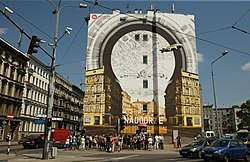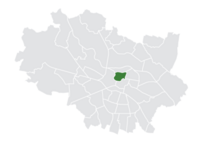Nadodrze (Polish pronunciation: [nadˈodʐɛ]) is a district in Wrocław, Poland, separated in 1991 from a larger district, Ołbin, which now lies to the east of it. It also borders Kleczków to the north and the Old Town to the west.[2][3][4] Nadodrze was incorporated into the city in 1808, after the demolition of the city fortifications.
Nadodrze | |
|---|---|
 Nadodrze Gate, Łokietka Street | |
 Location of Nadodrze within Wrocław | |
| Country | |
| Voivodeship | Lower Silesian |
| City | Wrocław |
| Population (2017)[1] | |
• Total | 24,828 |
| Time zone | UTC+1 (CET) |
| • Summer (DST) | UTC+2 (CEST) |
The neighborhood was a historically poor and dangerous area, but since 2005 it was redeveloped, and became known for its arts scene.[5][6][7] It is sometimes compared to Berlin's Kreuzberg or Rome's Trastevere.[8][9]
Location
editWithin the boundaries of Nadodrze, there is Kępa Mieszczańska island, and important objects of urban infrastructure: Wrocław Nadodrze train station, streetcar depot No. 2 at Słowiańska Street, and Wrocław Combined Heat and Power Plant.[10] The seat of the Nadodrze Housing Estate Council is located at 43 Rydygiera St.[11] In 2017, about 25 thousand people lived within the boundaries of Nadodrze.[12] The district is one of the most densely populated areas in Wroclaw.[13]
History and development
editNadodrze is known both for its historical kamienice and for its industrial development. Soon after World War II and the transfer of the city to Poland, the demographic composition of the population changed. Richer residents began to settle elsewhere, leading to a gradual decline, an increase in poverty and crime, and infrastructural decay.[14]
The revitalization of Nadodrze began only in 2005, and soon the neighborhood became the "symbol of Wrocław's revitalization".[15][16] Dozens of historic houses, two main squares, schools, parks, and public spaces were renovated. Revitalization was also accompanied by the mass privatization of private apartments. Some researchers saw in the revitalization process a threat of gentrification.[15] The city's program was criticized because it concentrated on cosmetic changes rather than attempts to improve the quality of life of the neighborhood's residents.[15]
The Łokietka 5 – Infopunkt Nadodrze is a center for supporting activities for the development of Nadodrze.[15][17][18] It deals with cultural initiatives, coordinates inhabitants and local authorities, and brings together various communities functioning in Nadodrze.
One of the new tourist attractions of Nadodrze is colorful courtyards at 14–16 Roosvelta Street.[19] The work (niemural), which is a combination of ceramics, painting, and sculpture, is a joint effort of local residents in cooperation with Wroclaw artists and students of the Academy of Fine Arts. It is 250 meters long and covers an area of 1200 square meters.[19] The neighborhood is also famous for its numerous cafes, stores, and art galleries.[15][5]
In 2014, Nadodrze's Kurkowa Street was used for filming of the Steven Spielberg film Bridge of Spies, a Cold War-era spy thriller. Working alongside the Wrocław Film Commission, the film's producers set the street up to resemble Berlin in the 1950s and 1960s.[20][21]
Gallery
edit-
Street art between Dubois and Pomorska streets
-
Mural by Blu, Pomorska Street
-
Wrocław Nadodrze train station
-
Crossroad of Chrobrego and Jagiellończyka streets
-
Świętego Macieja Street
-
Kurkowa Street was a shooting location for Bridge of Spies
Famous people
edit- Anna German, Polish singer
See also
editReferences
edit- ^ "Biuletyn Informacji Publicznej Urzędu Miejskiego Wrocławia".
- ^ "ArcGIS Web Application". gis.um.wroc.pl. Retrieved 26 March 2021.
- ^ Gdzie kończy a gdzie zaczyna się wrocławskie Nadodrze?
- ^ Redakcja (9 April 2013). "Mój Reporter: Czy Wrocław będzie większy?". Gazeta Wrocławska (in Polish). Retrieved 23 March 2021.
- ^ a b "Why Nadodrze is the best part of Wroclaw". WroclawGuide.com. 7 December 2019. Retrieved 26 March 2021.
- ^ "Unusual Nadodrze – guided tours around the district". VisitWroclaw.eu. Retrieved 26 March 2021.
- ^ "Travel: Nadodrze". Warsaw Insider. 7 March 2017. Retrieved 26 March 2021.
- ^ Welle (www.dw.com), Deutsche. ""TAZ" donosi z Wrocławia: Nadodrze jak Kreuzberg | DW | 22 July 2015". DW.COM (in Polish). Retrieved 26 March 2021.
- ^ "Kinomural – moving murals in Nadodrze | go.wroclaw.pl". wroclaw.pl/go/. Retrieved 26 March 2021.
- ^ "Ogólnopolska Baza Kolejowa". www.bazakolejowa.pl (in Polish). Retrieved 23 March 2021.
- ^ "Osiedle Nadodrze – Wrocławskie osiedla – Biuletyn Informacji Publicznej Urzędu Miejskiego Wrocławia". bip.um.wroc.pl. Retrieved 23 March 2021.
- ^ Liczba mieszkańców zameldowanych na pobyt stały i czasowy (stan na 31.12.2017).
- ^ Problemy społeczne w przestrzeni Wrocławia. Stanisław Witold Kłopot, Mateusz Błaszczyk, Jacek Pluta. Warszawa: Wydawnictwo Naukowe Scholar. 2010. ISBN 978-83-7383-467-5. OCLC 750734081.
{{cite book}}: CS1 maint: others (link) - ^ Witkowski, P. (2013) ‘Kaletnik, witrażysta i koronkarz czyli rewitalizacja Nadodrza,’ [Leather craftsman, stained-glass maker and lace-maker: Nadodrze’s revitalisation] Miasta, no. 2 (1/2013), pp. 62–65.
- ^ a b c d e Kębłowski, Wojciech. "Revitalisation versus gentrification in contemporary urban studies. The case of Nadodrze".
{{cite journal}}: Cite journal requires|journal=(help) - ^ Adamczyk-Arns G., Bąkowski J., Dudek J., Górka P., Ruman H., Szewczyk G., Przedmieście Odrzańskie: Masterplan Analizy, Wrocław 2011.
- ^ "Wrocław Nadodrze: Another World Across the Oder River". www.inyourpocket.com. Retrieved 23 March 2021.
- ^ "Łokietka 5 – Infopunkt Nadodrze". Łokietka 5 – Infopunkt Nadodrze (in Polish). Retrieved 23 March 2021.
- ^ a b "Kolorowe podwórko przy ul. Roosevelta na Nadodrzu". VisitWroclaw.eu (in Polish). Retrieved 23 March 2021.
- ^ "Steven Spielberg in Wrocław". www.wroclaw.pl. Retrieved 26 March 2021.
- ^ "Steven Spielberg we Wrocławiu. Zaczynają się zdjęcia do filmu". TVN24 (in Polish). Retrieved 2 April 2021.
External links
edit- Official website
- The alternative Poland on show in Wrocław, The Guardian
- Media related to Nadodrze, Wrocław at Wikimedia Commons